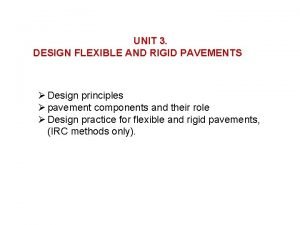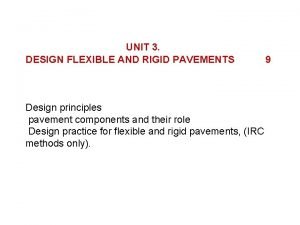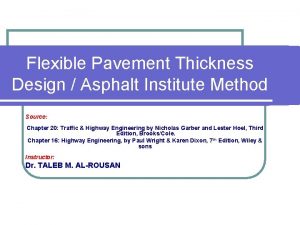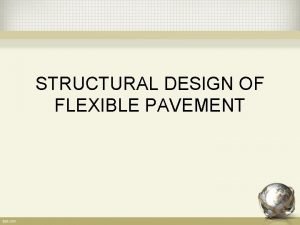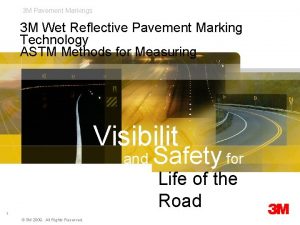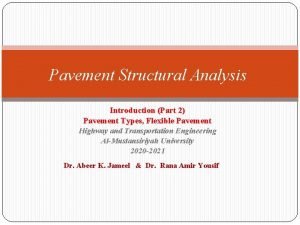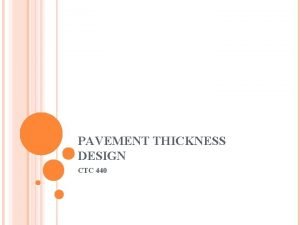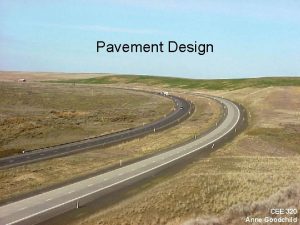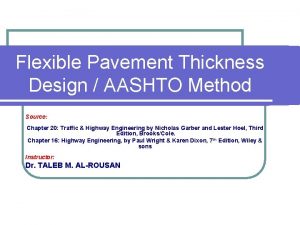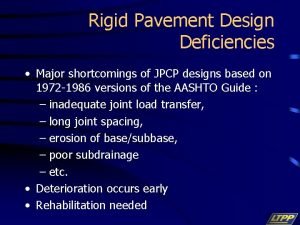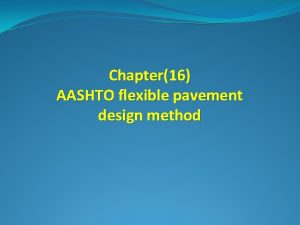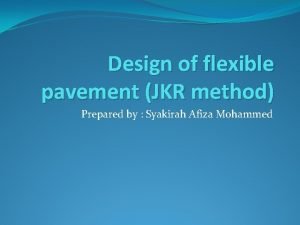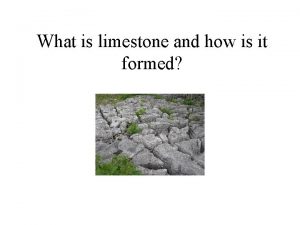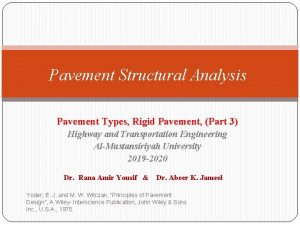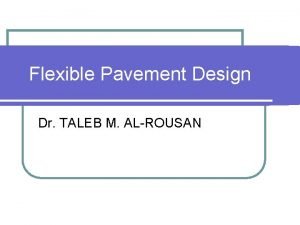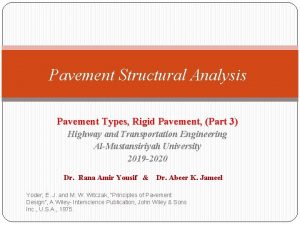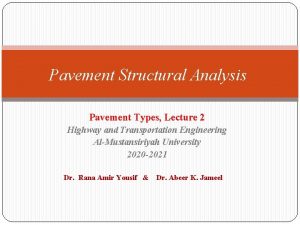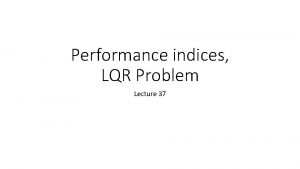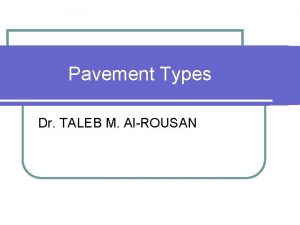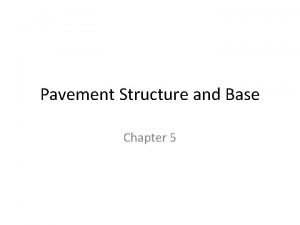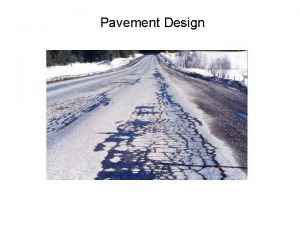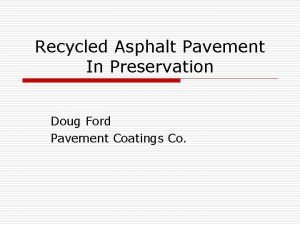Lecture 12 Lecture 1 L PAVEMENT CONDITION INDICES




























- Slides: 28

Lecture 12 Lecture 1 L PAVEMENT CONDITION INDICES

Instructional Objectives n Historic development of pavement condition indices n The basic functions of condition indices in PMS n Different types of condition indices n Development of a pavement condition index

Present Serviceability Rating

Present Serviceability Index PSI = 5. 02 -log(1+SV)-1. 38(RD)2 -0. 01(C+P)1/2 Where: PSI = Statistical estimate of the Mean PSR SV = Slope variance (roughness) RD = Rut Depth C = Cracking (ft 2 / 1000 ft 2) P = Patching (ft 2 / 1000 ft 2)

Need for Pavement Distress Indices n Trigger treatments n Calculating life-cycle costs n Evaluate network conditions n Compare roads with different distress

Pavement Condition Indices Development Computed using a very simple deduct based formula: n n PCI = PCImax - Deduct Value Example 100 - 40 = 60

Pavement Condition Indices Development (cont'd) n n n Transform pavement condition data into pavement condition indices Deduct values developed for various levels of distress severity and extent Two basic approaches - Expert opinion - Engineering criteria

Example: Pavement Distress Trend

Deduct Value Table From Expert Opinion

Pavement Distress Curve n Plot condition index versus age n Produces a pavement performance curve n Shape and trend of resulting curve is dependent on deduct value developed

Pavement Performance (Using deducts from Expert Opinion)

Engineering Criteria Approach: Index Scale n Scale used for condition index n Scale chosen to meet agency needs and perceptions n Typical scales are 0 -100, 0 -10, 0 -5

Engineering Criteria Approach: Threshold Value n n n Index value representing unacceptable pavement condition Typically taken as middle of an index scale, such as 50 (0 -100 scale) or 2. 5 (0 -5 scale) May be set to represent a range such as 40 to 60 (0 -100 scale) or 2 to 3 (0 -5 scale)

Engineering Criteria Approach: Engineering Criteria n n n Pavement distress level (severity, extent), considered unacceptable Amount of distress for each severity level where action should be taken to correct distress May be numerically different for various types of distress

Engineering Criteria Example n Use a 100 to 0 Scale n Set Threshold Condition Value at 50 n Set Engineering Criteria 90% Low Severity Cracking 25% Medium Severity Cracking 15% High Severity Cracking

Engineering Criteria Example n Develop Plot of Deduct Values - All three severities start at 0 and pass through the threshold value of 50 at the engineering criteria selected - In this example they pass through the threshold value of 50 at 15%, 25%, and 90% for low, medium and high severity cracking

Development of Deduct Values

Engineering Criteria Example n n Develop Final Deduct Values from relationships shown on plot The Deduct Values may be developed as set of continuous functions which may be shown: - as a plot of a chart - as a formula - as a set of deduct tables

Example Deduct Value Table (Straight Line approach)

Pavement Performance Using deducts from Engineering Criteria

Pavement Deduct Values ASTM D 5340 “Paver” “Based on Engineering Experience”

Pavement Performance Using deducts from ASTM D 5340

Pavement Deduct Values Using Log-Log Chart

Pavement Performance Using deducts from Log - Log approach

Distress Index Development Basic Criteria n n Scaled deduct values so resulting condition index threshold value occurs near middle of scale Transition of deduct values should produce reasonable smooth performance curve matching trends of distress observed in field

Current Practices n 1994 - NCHRP Synthesis 203 survey n 50 states / 9 provinces n Roughness (IRI) use increased sharply n Structural capacity - vary widely n Friction / skid testing - not common at network level

Current Practices n Distress info - most variation - field procedure - distress definitions n Little opportunity to exchange information n Approximately. 80% of agencies use - distress index - serviceability index/rating - priority rating n No evident trends in development n 67% use composite indices (roughness)

Instructional Objectives n Historic development of pavement condition indices n The basic functions of condition indices in PMS n Different types of condition indices n Development of a pavement condition index
 Flexible pavement vs rigid pavement
Flexible pavement vs rigid pavement Flexible and rigid pavement
Flexible and rigid pavement What is rigid pavement
What is rigid pavement Gd&t symbol
Gd&t symbol 01:640:244 lecture notes - lecture 15: plat, idah, farad
01:640:244 lecture notes - lecture 15: plat, idah, farad Asphalt pavement thickness design
Asphalt pavement thickness design Semi flexible pavement
Semi flexible pavement Limestone pavement labelled diagram
Limestone pavement labelled diagram Quiet asphalt pavement
Quiet asphalt pavement Hrs types
Hrs types Pavement structural design
Pavement structural design White topping concrete pavement
White topping concrete pavement Pavement
Pavement Parts of pavement
Parts of pavement Dfaringe
Dfaringe Jointed plain concrete pavement
Jointed plain concrete pavement Asphalt pavement design example
Asphalt pavement design example Base subbase subgrade
Base subbase subgrade Aashto rigid pavement design spreadsheet
Aashto rigid pavement design spreadsheet Drivers ed chapter 2 signs signals and roadway markings
Drivers ed chapter 2 signs signals and roadway markings Aashto flexible pavement design example
Aashto flexible pavement design example Flexible pavement cross section
Flexible pavement cross section Limestone cave diagram
Limestone cave diagram What is pavement evaluation
What is pavement evaluation Contraction joint in rigid pavement
Contraction joint in rigid pavement Carol ann duffy before you were mine
Carol ann duffy before you were mine Aashto design equation
Aashto design equation Asphalt pavement design example
Asphalt pavement design example Faa pavement design
Faa pavement design
